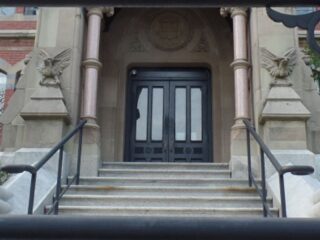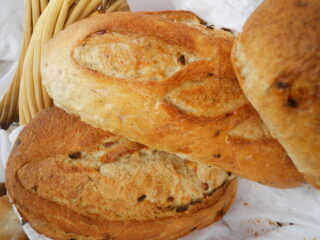by Deborah Straw
Like many other famous writers, E.B. White (1899-1985) was a shy man. He avoided most parties and public appearances. He didn’t want people to find him or his home in North Brooklin, Maine. In his latter days, he stopped giving interviews. In 1977, he convinced the reporter Herbert Mitgang to write, “To discourage visitors, we hereby report that he lives in ‘a New England coastal town,’ somewhere between Nova Scotia and Cuba.” If White wanted people to find him, he would graciously invite them to do so. He wanted people to read his work and appreciate it for what it was: a humorous and insightful collection of essays, poems, and children’s books that continue to touch generations of readers. Otherwise, he would have advised, please, leave this quiet, humble man alone to create in relative solitude.
Solitude, that is, if you’re not counting the animals and birds he and his wife Katharine lived with on their small farm. Aside from the ever-present dog, often a dachshund like the infamous Fred, White generally shared his home with sheep, chickens, a pig, and a cat. And, oh yes, all those spiders. All descendants of Charlotte, of course. And yes, the barn on this property was where this great adventure took place, or at least the incident on which White based Charlotte’s Web. White would not have wanted anyone just dropping by. If a reader receives an urge to visit the scene of the stories, he may rather you sit down with Charlotte’s Webor with the cassette tape of White reading it. Incidentally, it took White several tries to read it for the recording, because he kept getting choked up when he came to the crucial parts of the story. You know which parts I mean.
Although E B. White was born in Mount Vernon, New York, he lived in two very disparate places as an adult: Manhattan and tiny North Brooklin, Maine. The latter isn’t even on a general map. White loved New York and North Brooklin, but in his heart, he was more a New Englander than a New Yorker. He and Katherine also spent several winters in Florida, especially as they aged and Katherine’s various ailments required a warmer, sunnier climate in the winter. But the place where he felt most comfortable was undeniably his beautiful white house and acreage in Maine with all of the critters under foot. He had a large barn and small boathouse there that became his studio, where he sat at a small table and used a manual typewriter to write his many drafts.
North Brooklin is slightly north of Brooklin, a tiny seaside community in Maine, about half way between Camden and Bar Harbor. As of the 2000 census, the larger Brooklin had a population of 841.
During his New York City days, as a writer and columnist for The New Yorker, White was not fully able to indulge his love for animals, insects, and birds. However, in the fall of 1933, he and Katherine began to spend parts of the year in North Brooklin, and White was finally able to interact with and care for all kinds of creatures. The couple raised eyebrows when they first made the decision to go rural. They had both worked full-time at The New Yorker for decades. “A good many people down here in New York seem to think that going to live on a farm the year round, especially a farm so far away, is some sort of height of affectation. They seem to think that you must be either washed up or very rich to do it. But we just wanted to do it,” White told interviewer Robert Van Gelder in 1942.
One of the major reasons White moved to the country was to have more animals and to sail, a life-long passion. In fact, his son Joel ended up building boats and running a boatyard in Brooklin. White also chose Maine because he had fond memories of childhood stays at a camp on a Maine lake. His essay, “Once More to the Lake,” centers on a visit to a lake with his son, recalling his earlier visits with his own dad.
The animals were around constantly and provided inspiration for the essayist. “I like animals, and it would be odd if I failed to write about them. Animals are a weakness with me, and when I got a place in the country I was quite sure animals would appear, and they did,” he wrote in 1953.
White came by this love of animals from his parents. He was born in Mount Vernon, New York in 1899. His mother, Jessie Hart White, loved all creatures. In an early letter to her son, Jessie “spoke with pleasure of her flowers in the yard and of a new brood of baby chicks. Her strong motherly love must have helped implant in her son his lifelong fascination with the miracle of birth and his reverence for life’s cycles,” writes White’s biographer, Scott Elledge. He inherited what he called a “passionate love of the natural world” from his father, Samuel Tilly White, and the month they spent every summer in the Maine woods.
Somewhat surprisingly, White admitted he wasn’t a great reader, although he was clearly a great listener and observer. However, White’s favorite book was Henry David Thoreau’s Walden, and he shared many of Thoreau’s ideas. White carried a copy of Walden with him and wrote about it in several essays and letters. Many writers are considered proteges of Thoreau and White is one of them: He loved solitude, freedom of expression, nature, and other creatures, and like Thoreau, he realized that humans are not the dominant species. Critics have likened the two men in their interests and love of precise natural detail.
Of all the animals he loved, White seemed most taken with dogs. As a child, White almost always had a dog in his arms or by his side. There was quite a long series of dogs in the White household, but the two that make the most long-lasting literary impression are Jones, a Norwich terrier, and Fred, a dachshund. For many years, their names appeared in his columns, letters, and poems as often, if not more so, than his wife or children’s names. Like many shy people, White spent much time observing and conversing with these animals, and sometimes preferred their company to that of humans.
Jones, the Norwich terrier, was a feisty, barking, tenacious dog. Early in his life, Jones had been struck by a trailer and nursed “bruised bones and wounded feelings all through April.” Jones also almost lost his home at one point because, as Isabel Russell, the Whites’ personal secretary for eight years, recalled, “Jones’s horoscope for April would seem to indicate he had been born on the dark side of the moon. By sad mischance he contrived to bite local citizen Bill Allen, husband of Ks faithful, long-time housecleaning helper, Virginia. Bill died a year later but his demise had nothing to do with the dog bite.”
As a result of the unfortunate biting incident, White felt Jones needed to live with someone who could give him “individual attention while keeping him sequestered.” But the entire family realized that Jones was a one-man dog, i.e., White’s, and the attempt to find him a new home slowly evaporated.
“He continues to fight the good fight,” said his master, “and he resembles me in so many ways it’s incredible. He doesn’t know enough to give up when he’s licked.” In a January 1980 letter, long after the terrier’s death, White noted “how remarkable it was that such a small dog could leave such an immense hole in the house by his absence.”
Perhaps the most famous of his dogs, and the one most fondly remembered by readers because of “Death of a Pig,” is Fred, the dachshund. In a letter in 1951 to the Collector of Internal Revenue in Bangor, in which he explains why he owed back income tax, White recalls Fred and the family’s other dachshund Minnie. “Both these dogs, as a matter of fact, had rheumatoid tendencies, as well as a great many other tendencies, specially Fred. He’s dead, damn it. I would feel a lot better this morning if I could just see Fred’s face, as he would know instantly that I was in trouble with the authorities and would be all over the place, hamming it up. He was something.”
Fred was truly something, a presence to consider. In “Death of a Pig,” we learn that the dog surveyed his property regularly and seemed to feel in charge of all goings on. “Fred was restless,” White writes in the aforementioned letter. “Death of a Pig” is, of course, related to White’s fondness and empathy for pigs and also to Charlotte’s Web. In this 1947 essay, he relates that he has a sick pig, which may have to be put down. Fred seemed to enjoy this somber occasion far more than his human companion did. “As my own spirits declined, along with the pig’s, the spirits of my vile old dachshund rose He never missed a chance to visit the pig with me, and he made many professional calls on his own.” The pig died a day or two later despite various treatments, and the gravediggers dug a hole at the foot of an apple tree. The gravedigger “was standing in it, removing the last spadefuls of earth while Fred patrolled the brink in simple but impressive circles.”
They buried the pig, and White threw in the first shovelful of dirt. “I picked up the rope, made it fast to Fred’s collar (he is a notorious ghoul), and we all three filed back up the path to the house, Fred bringing up the rear and holding back every inch of the way, feigning unusual stiffness. The grave in the woods is unmarked, but Fred can direct the mourner to it unerringly and with immense good will, and I know he and I shall often revisit it, singly and together, in seasons of reflection and despair, on flagless memorial days of our own choosing.” White often attempted to ease death’s burden by including animals in his works.
Of course, this gentleman farmer also had spiders in his barn. In fact, his barn in Maine is where he came to notice and eventually be greatly enthused about spiders. Although White’s “children’s book,” Charlottes Web, is now 54 years old, the story holds up as strongly as when it was written. Over those years, Charlotte’s Web has reached and touched millions of readers and continues to do so. Publishers Weeklylists the book as the best-selling children’s paperback of all time, selling an excess of 45 million copies and having been translated into more than 20 languages.
This timeless story of friendship and community, of necessity and death, loss and rebirth, continues to charm and move readers, both young and old. What White did in this piece of writing–aside from penning an almost perfect tale using precise language and famously concrete details–was to raise an awareness of spiders that most people do not have. Like Albert Schweitzer, especially in terms of his “reverence for life” theory, White lets us into the lives of several creatures that many people might not otherwise even think about. And like Virginia Woolf in her “Death of a Moth” essay, he elevated the spider’s status higher than it had ever been.
White often kept pigs. He liked them. “One day when I was on my way to feed the pig [note that he does not write ‘my’ pig], I began feeling sorry for the pig because, like most pigs, he was doomed to die. This made me sad. So I started thinking of ways to save a pig’s life. I had been watching a big grey spider at her work and was impressed by how clever she was at weaving. Gradually I worked the spider into the story that you know, a story of friendship and salvation on a farm,” he told the poet Lee Bennett Hopkins.
In an interview with Justin Wintle and Emma Fisher for their book about children’s writers, The Pied Pipers, White further explained his story: “I used to raise a spring pig, for butchering in the fall, and I never much cared for this deliberate murder, so I invented a way to save a pig’s life. Charlotte’s Web was an easy book for me to write because of my intimate connection with the main characters.”
It is important to note that E. B. White was ahead of his time in looking at animals as he did, especially farm animals. I know that most farmers did not assign personal attributes to farm animals. My dad grew up on a farm in Vermont and was only slightly older than White. As a young man, my dad, who later loved and respected all creatures, used to drown unwanted litters of barn kittens in the river.
In his New York Times essay, “Appreciating E. B. White,” Christopher Lehman-Haupt wrote, “In his respect for ecology, he was way ahead of the counterculture. He came to understand early in his life that faster and bigger and more are not necessarily better, that nature has her secret ways of compensating for what humankind does to her, and that, at least for him, a life close to the land is the one best suited to the rhythms of the human temperament.”
In a brief article in The New York Timeson May 14, 1961, White wrote, “All that I ever hope to say in books is that I love the world. I guess you can find that in there, if you dig around. Animals are part of my world and I try to report them faithfully and with respect.”
Charlotte and Wilbur no longer live on the North Brooklin farm, nor do any of the Whites. But E. B. White paved the way for his readers to care more for other creatures, for community, for friends, and for family. Such is his stunning legacy. Go into any barn with cobwebs, or to the Maine coast, and you will find E. B. White’s spirit there.
Selected Titles:
THE FOX OF PEAPACK, 1938
QUO VADIMUS, 1939
A SUBTREASURY OF AMERICAN HUMOUR, 1941 (ed. with Katharine Sergeant Angell)
ONE MAN’S MEAT, 1942
STUART LITTLE, 1945
THE WILD FLAG, 1946
HERE IS NEW YORK, 1949
CHARLOTTE’S WEB, 1952
THE SECOND TREE FROM THE CORNER, 1954
THE POINTS OF MY COMPASS, 1962
E.B. WHITE READER, 1966
THE TRUMPET OF THE SWAN, 1970
LETTERS OF E.B. WHITE, 1976, ed. by D.L. Guth
ESSAYS OF E.B. WHITE, 1977
POEMS AND SKETCHES OF E.B. WHITE, 1981
WRITINGS FROM THE NEW YORKER, 1925-76, 1990








